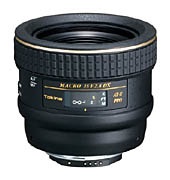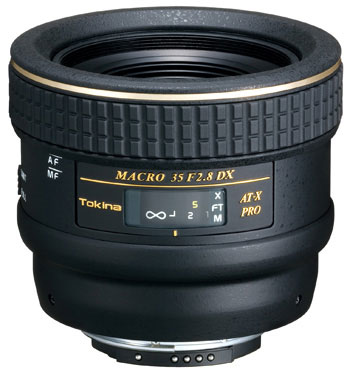NEW TOKINA AT-X M35 PRO DX Digital Macro Lens

LONG BEACH, CA. (January 1, 2008) THK Photo Products, Inc., announces the Tokina AT-X M35 PRO DX 35 mm f/2.8 macro lens exclusively for Digital SLR cameras with APS-C sensors.*
When used on digital SLR cameras the AT-X M35 PRO DX lens gives the same angle of view as a 52mm lens. The close focusing distance of the M35 is an amazingly close 5.5 in. (14cm) yielding a macro ratio of 1:1 or life-sized reproduction with excellent sharpness. Its compact size makes it easy to carry almost everywhere and the wide f/2.8 aperture allows for easier viewing in low light situations.
The front element of the AT-X M35 PRO DX has a newly formulated WP or “Water Proof” optical coating on the glass. This new coating makes marks such as spots left by water or finger-prints much easier to clean than standard multi-coating.**
Tokina’s exclusive One-touch Focus Clutch Mechanism allows the photographer to switch between AF and MF simply by snapping the focus ring forward for AF and back toward the camera to focus manually. There is no need to change the AF-MF switch on Nikon cameras*** and there is no second AF/MF switch on the lens for Canon, everything is accomplished by the focus ring.
* The lens is designed for Digital cameras with APS-C sized CMOS and CCD sensors, not designed for cameras with Full Frame sensors.
** Please note, the Tokina AT-X M35 PRO DX lens itself is not waterproof or water resistant.
*** Will not AF when used on Nikon D40 SLR camera body.
THK Photo Products, Inc. is the U. S. distributor for Tokina lenses, Hoya filters, Kenko photo accessories and SLIK camera support systems. THK provides marketing, sales, distribution, and technical/consumer service and support. THK is located in Long Beach, CA and on the Web at www.thkphoto.com.
Specifications
Focal Length: 35mm
Maximum Aperture: F/2.8
Minimum Aperture: F/22
Construction: 9 element in 8 groups.
Coatings: Multi-layer
Angle of View: 43°
Minimum Focus Distance: 5.5 in. (14cm)
Macro Ratio: 1:1
No. Aperture blades: 9
Filter Size: 52mm
Lens width: 73.2mm
Lens length: 60.4mm
Weight: 340g
Accessories: Metal Hood (MH522)
Mount Availability: Canon and Nikon APS-C



Hi
I have the Sony a350 dslr. I am writing to you because to date, I have not got a simple straight answer to my simple question, asked of others. I trust you.
All I have asked is this. I want a lens to fit my camera that will allow me to capture a crisp clear image of the tiny tiny red spider mite, which is less than half a milimeter in size. I wish to see everything on that tiny creature. My question is WHICH lens for my camera, is the best for doing this capture??
I also asked this. I seek a lens (NOT a prime lens) that will allow me to capture the splatters inside of the Moon. I already have a 200mm lens and can capture the “man in the moon” image, but I wanna get right in there. I also want to use this lens to capture a shot of a bird just 2 inches long. This bird is very nervous so I will need to be no closer than 100 meters from it. But like the tiny mite, I want to see every detail of this bird. My question is WHICH lens for my camera, is the best for doing this capture. OR (or)
Is there a SINGLE lens that would fit my camera and will enable me to do both tasks????
Byeeee from
Graeme
Hey graeme,
I noticed your question here. This is not the focal length you are after. For taking hi-res images of the moon or wildlife you want a long lens (~400mm).
Not sure about Sony stuff as I use Canon, but you could get a x2 extender for your lens to give it more reach to get closer to the moon. Either that or get a longer lens.
Macro is for getting the lens very close to something and still being able to focus on the object…